Community Gets Ready for Sunday’s CicLAvia: “It’s Going to Be a Good Day for South L.A.”
4:02 PM PST on December 3, 2014
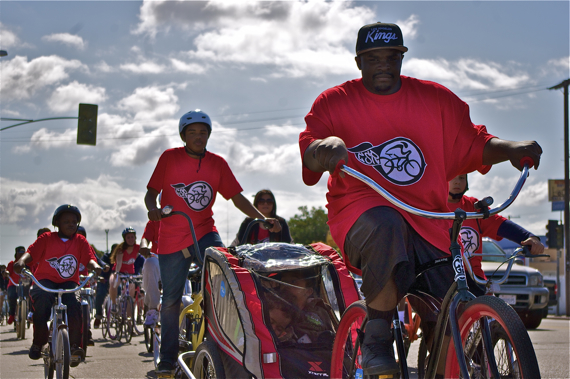
It was exciting, said Community Health Council's (CHC) Andres Ramirez Huiztek, that South L.A. would finally have the opportunity to "show [people] what CicLAvia can be" this weekend.
If you've attended a CicLAvia event before -- a festival that spans and connects communities by temporarily closing the streets to cars and opening them to people for recreation -- you might be wondering, "Which people? What kind of CicLAvia? A car-free festival really isn't that complicated, is it?"
In theory, no.
But, in practice -- particularly in the planning of the expansion to new communities -- it can be.
As CicLAvia organizers and volunteers have learned while putting together events in Boyle Heights/East L.A. and South L.A., communities that have long been marginalized by the city often have different relationships with their streets and different ideas about what it means to be "livable." And as these communities often consider their people -- their unique identities, heritage, shared experiences, cultures, and aspirations -- to be their greatest assets, they are adamant that they be seen as more than just a space people will move through. They want to be respected as partners in the planning of how their streets will be re-purposed for the day. And they want to see themselves reflected in the framing of the event and the messaging around it, both so the event feels welcoming to community members unfamiliar with it and to ensure the community is adequately and accurately represented to potential visitors.
In this way, CicLAvia seems to be transitioning from being an "open streets" event to a kind of "open communities" festival. And while that process is not without its growing pains, the unique opportunity it affords neighborhoods to re-introduce themselves to Angelenos on their own terms may help bridge some of the deep divides that mark what can be a surprisingly segregated city.
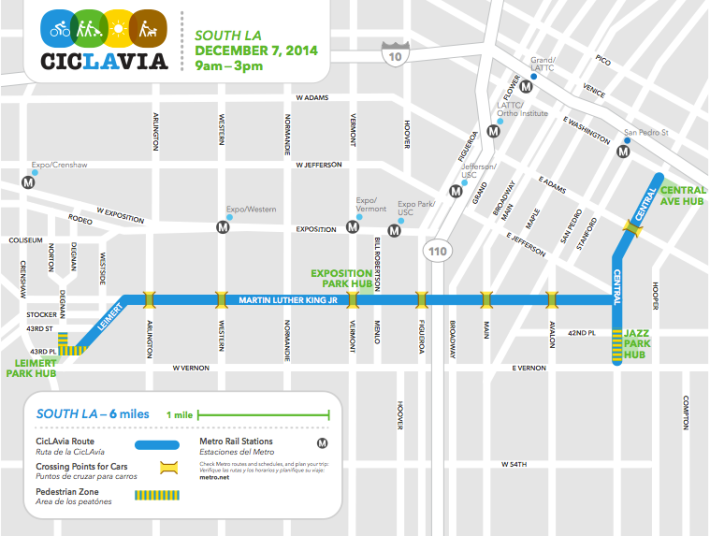
At least, I hope so.
For South L.A., that means a chance to counter persistent negative stereotypes by introducing people to the diversity and vibrancy of the neighborhoods that comprise the area, showcasing their powerful artistic heritage and the artists carrying those (and new) legacies forward, and shining a light on those community heroes who have tirelessly worked to strengthen their communities from within.
For South L.A. native and advocate-extraordinaire Tafarai Bayne, this day has been a long time coming.
Growing up, he had always felt the area had something special to offer the rest of the city, he said, but there weren't too many outlets for positive exchanges to happen. In 2010, when he rode in his first CicLAvia and saw how it was able to both transform the streets and push people to explore unfamiliar neighborhoods, he was inspired to do the same for his community. A similar event in South L.A., he felt, could finally provide the venue for residents and visitors alike to experience the strong sense of place and community that characterize many of the area's neighborhoods.
He approached the leaders at TRUST South L.A., where he worked at the time, and asked how they could host such an event in the area.
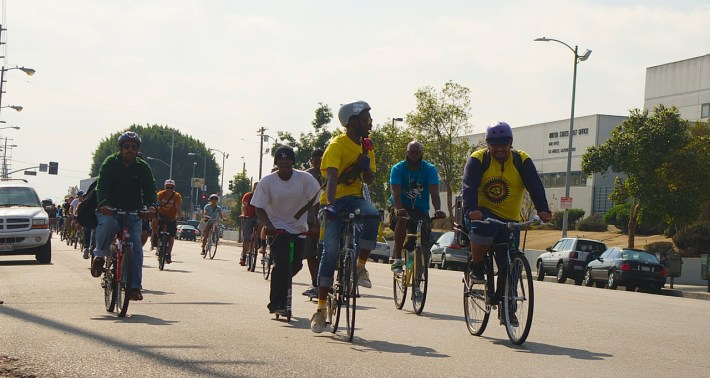
At the time, TRUST -- which does fantastic work around housing issues -- had done some work on mobility, but mainly in regard to pedestrian issues. Thanks to Bayne's persistence, they expanded their advocacy efforts to work on a wider range of active transportation issues.
In the last few years, they've worked with the LACBC on an Active Streets South L.A. program and (also with CHC) an effort to build momentum around bike lanes for Central Ave., worked with USC on asset mapping, and collaborated with advocates from CHC to regularly convene mobility advocates to discuss issues affecting the area, plan events to advance mobility goals, and ensure advocates' voices were incorporated into city planning efforts.
But it was Bayne's push to bring CicLAvia to South L.A. that helped give the area's budding bike "movement" some much-needed momentum.
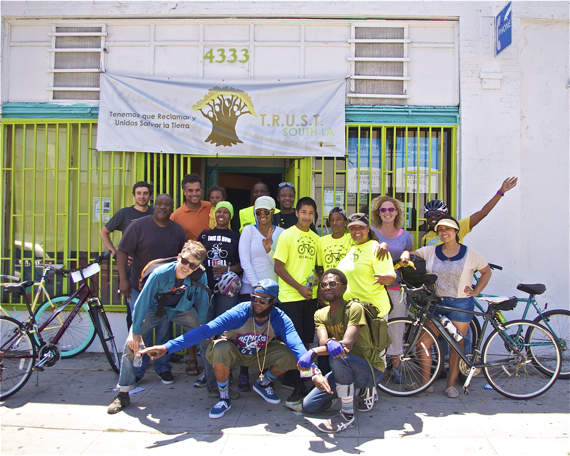
When Bayne had contacted SBLA's own Joe Linton, one of the original CicLAvia organizers, for help on putting together a South L.A. route back in 2010, Linton (although very enthusiastic) had explained doing so would likely involve a lengthy process. As the organizers were interested in expanding the route but weren't as familiar with other areas of town, he says Linton suggested setting up a framework and structure as a way to formalize the effort.
Those conversations resulted in the CicLAvia South L.A. Host Committee -- a group comprised of residents and representatives of area advocacy organizations that could map potential routes and conduct exploratory rides while gathering local support for hosting such an event in the area.
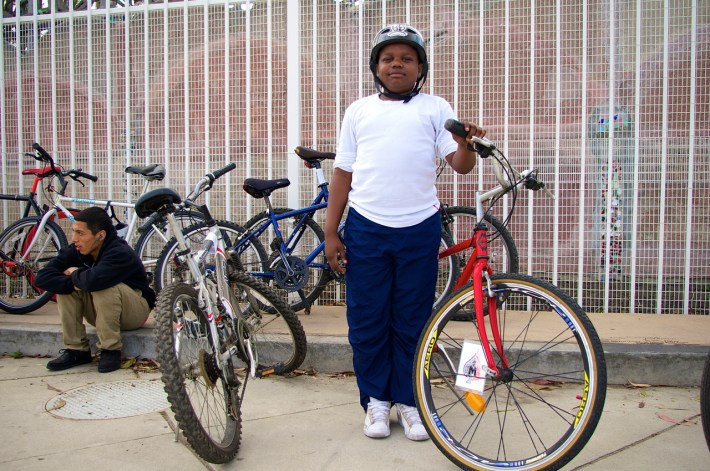
I first tagged along with the group on a ride through Watts in early 2012 and got hooked on documenting the momentum the events gave South L.A.'s own brand of bike movement, how they helped the East Side Riders and Los Ryderz bike clubs (who took on the role of marshaling the rides) become powerful ambassadors for the area, and the way the rides instilled a greater sense of family, community, and common cause in participants.
They also spawned an effort to bring ciclovia-style events to the Southeast cities of Huntington Park and South Gate, thanks to the work of former Ovarian Psycos Mayra Fernandez and Yolanda Posada, Andres Ramirez from CHC, and others from the area.

What was so wonderful about watching the wider South L.A. movement grow was seeing it remain organic and true to its roots.
Social justice was always a part of the conversation. Rides were never just about riding bikes. They were about offering the youth of the area something positive to belong to and instilling a culture of giving back, building unity between black and brown residents, raising awareness about police brutality against people of color, feeding the homeless, projecting positive images of South L.A., inspiring the community, raising the profile of riders of color, and/or giving visibility to the so-called "invisible cyclists" (lower-income and/or immigrant riders that bike for transportation and do not easily fit into the "bike community") so common in the area.
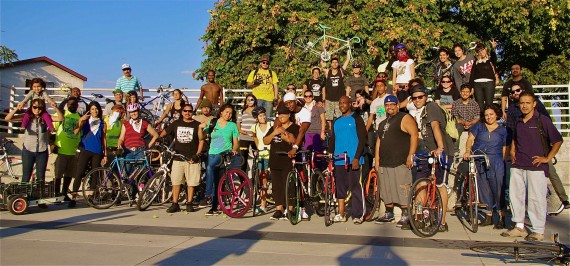
That dedication to community empowerment and social justice will be evident at the hub on Central Ave., CHC's Ramirez told me.
Which, given current activism in the area and the history of struggle along Central Avenue, seems apt.
The history of the stretch of Central known as the Jazz Corridor is one that is deeply intertwined with the efforts of African-American artists and intellectuals to rise above the constraints that overtly discriminatory policies once imposed upon them. The Dunbar Hotel (at 42nd and Central) -- the anchor of the Jazz Park Hub on Sunday -- was the only major hotel in the city that welcomed African-Americans in the decades prior to WWII. The Dunbar and its jazz club became the place to see all the greats -- Duke Ellington, Louis Armstrong, Count Basie, Lena Horne, Ella Fitzgerald, Billie Holiday, Nat King Cole, Ray Charles -- who were welcome to play at hot clubs and hotel lounges around town, but never to stay. The Dunbar's club drew dignitaries, intellectuals, and writers, as well, including W.E.B Du Bois and Langston Hughes, and could always count on a packed house, as restrictive housing covenants had created ethnic enclaves along the corridor of folks who were hungry for culture but denied access to it elsewhere.
While events and entertainment are planned that will celebrate some of that rich jazz heritage, as many as 25 community-based organizations currently working to transcend the legacy of disinvestment along the corridor will also be on hand as part of a community health expo. They hope to engage residents (and interested visitors) on issues of import to the area, offer information about the services they provide, offer cooking demonstrations and a healthy food tent, promote health and healthcare enrollment, host a "Bike Rodeo" for kids, activate a vacant lot along King Blvd., and lead feeder rides from area schools to ensure that local youth have the opportunity to enjoy open streets in their community.
It's a way to highlight all the great work groups are doing in the area, Ramirez concluded, while celebrating what the corridor signifies to residents.
"The neighborhoods are going to come out!" he said.
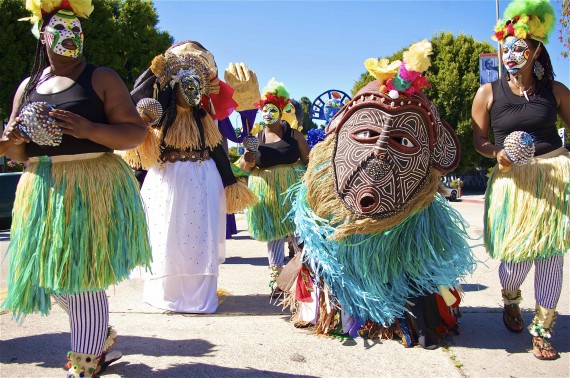
Stakeholders in Leimert Park Village -- the hub on the other end of the route -- are really hoping so.
Since the first community meeting on CicLAvia back in July, they've been working steadily with CicLAvia staff and volunteers and local stakeholders to reach out and inform residents about the event and strategize ways to showcase the area's assets. At their weekly meetings, stakeholders from the 20/20 Vision initiative -- an effort to bring about an artistic and cultural renaissance in Leimert Park -- regularly discussed ideas about how to take advantage of being put on center stage, so to speak. A herculean effort was made to prepare the People St. Plaza project for kick-off (unfortunately, that couldn't be managed and it will instead open on King Day in January) Volunteers chased down performing artists and vendors to populate the plaza and Degnan Blvd. Some even braved the rain last weekend to offer CicLAvia Explores tours around the Village so visitors could get a deeper sense of appreciation for its unique history, its contributions to the arts, and its significance as the cultural beating heart of the black community.
Leimert Park had originally been built in the 1920s as a middle-class white planned community. But the lifting of racial covenants, building of the freeways, and ease of access to suburbs via automobiles in the post-WWII era helped fuel "white flight" from Leimert and other inner city neighborhoods. African-Americans and Japanese immigrants were some of the first to move in. Then, unrest in Watts in 1965 and again in South L.A. in 1992 helped make Leimert Park a refuge for African-Americans seeking peace, fellowship, and healing.
Those with an artistic bent often congregated at 5th Street Dick's Coffee Company (a coffeehouse and performance space) or The World Stage, a non-profit arts, education, and performance gallery on Degnan Blvd. founded by master jazz drummer Billy Higgins and by poet and community arts activist Kamau Daáood. Writers, poets, and activists also flocked to writers' workshops there, seeking ways to empower themselves and others through the communication of their experiences.
And while the intensity of that scene has since faded, it is not unusual to stumble across some of those incredible artists at workshops, performances, or the Leimert Park Art Walk on the last Sunday of the month.
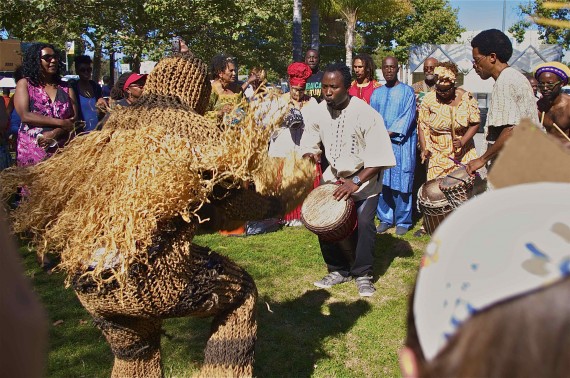
Stakeholders are looking to harness the power of that history as they work to push Leimert Park across the threshold of a creative cultural renaissance and to a place where it can nurture the talents of young black artists and innovators.
Hopefully, visitors to the area on Sunday will be able to see that vision and understand why making space for cultural communities is so important to building a healthier and more vibrant Los Angeles.
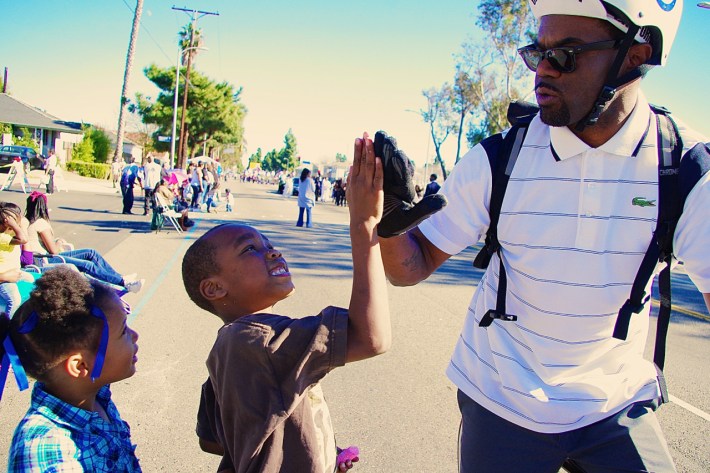
South L.A. is changing.
Rapidly.
And it's doing so in innovative ways that are driven from within. It's one of the reasons I enjoy working in the community so much.
But the real reason I love covering the area is more basic: it's the people. The big hearts, the warm smiles, the sense of community, and the desire of people to help others (even when they have very little themselves), combined with the diversity of the neighborhoods and rich cultures make every venture into the area a rewarding one.
I'm so pleased those of us who love the area finally have the opportunity to, as Tafarai Bayne put it, "welcome folks to enjoy [the] neighborhood." And I'm so grateful for the work that he, CicLAvia staff and volunteers, and other advocates have put in to bringing the event to the community so that residents have a chance to experience their own neighborhood in a new way.
"Any CicLAvia," Bayne explained, "is about more than what's in front of you;" it gives you a sense of place, a link to the past, and a sense of the future.
Then he smiled, "It's going to be a good day for South L.A."
* * * *
For more on CicLAvia, please click here. The list of events and tips for accessing the event can be found here.
Sahra is Communities Editor for Streetsblog L.A., covering the intersection of mobility with race, class, history, representation, policing, housing, health, culture, community, and access to the public space in Boyle Heights and South Central Los Angeles.
Stay in touch
Sign up for our free newsletter
More from Streetsblog Los Angeles
Eyes on the Street: New Lincoln Park Avenue Bike Lanes
The recently installed 1.25-mile long bikeway spans Lincoln Park Avenue, Flora Avenue, and Sierra Street - it's arguably the first new bike facility of the Measure HLA era
Brightline West Breaks Ground on Vegas to SoCal High-Speed Rail
Brightline West will be a 218-mile 186-mile-per-hour rail line from Vegas to Rancho Cucamonga - about 40 miles east of downtown L.A. - expected to open in 2028
This Week In Livable Streets
Active Streets Mission-to-Mission, LAPD reports on its use of force in 2023, Pasadena Transit plans, Metro subway construction, and more




